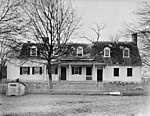St. John's Chapel of St. Michael's Parish
19th-century Episcopal church buildingsBuildings and structures in Easton, MarylandChurches completed in 1835Churches in Talbot County, MarylandChurches on the National Register of Historic Places in Maryland ... and 4 more
Episcopal church buildings in MarylandMaryland church stubsNational Register of Historic Places in Talbot County, MarylandTalbot County, Maryland Registered Historic Place stubs

St. John's Chapel of St. Michael's Parish is a historic Episcopal church at Easton, Talbot County, Maryland. It is a granite Gothic Revival ruin. The building measures 35 feet wide and 50 feet deep. The chapel was built in about 1835 and abandoned around 1895.It was listed on the National Register of Historic Places in 1973.
Excerpt from the Wikipedia article St. John's Chapel of St. Michael's Parish (License: CC BY-SA 3.0, Authors, Images).St. John's Chapel of St. Michael's Parish
Unionville Road, Easton
Geographical coordinates (GPS) Address Nearby Places Show on map
Geographical coordinates (GPS)
| Latitude | Longitude |
|---|---|
| N 38.796111111111 ° | E -76.128611111111 ° |
Address
Unionville Road
Unionville Road
21601 Easton
Maryland, United States
Open on Google Maps



